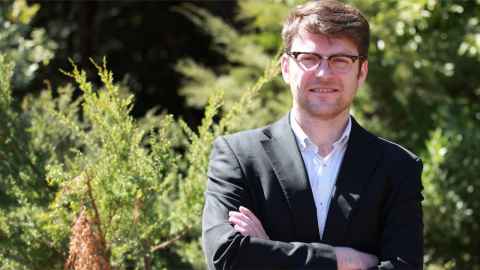Thomas Scelo
Director - Marshall Day Acoustics.

Few people will have heard of the term room acoustician.
Turns out there are very few of them in the world so don’t feel bad if you haven’t.
But after learning about soundwaves at school when he was 15, and being intrigued by the subject, Thomas Scelo decided to become one.
Born in France and with a passion for music and what it can do, Thomas arrived in New Zealand to begin his doctorate as a result of an invitation from George Dodd, Professor of Acoustics at the University, who he met while completing his Masters in Physics in France.
One of the attractions for choosing to study in NZ was having access to the University’s renowned Acoustic Research Centre (ARC), regarded as one of the leading facilities of its kind in the world, as well as having the opportunity to work alongside Sir Harold Marshall at the Faculty of Architecture, who was responsible for creating and developing the ARC.
“Sir Harold really cemented the relationship between the laboratory and the industry and co-founded, along with Christopher Day and Peter Fearnside, the consultancy Marshall Day Acoustics who I now work for. In fact, I was offered the opportunity and started to work for them within 30min of submitting my PhD thesis!”
Thomas has since gained extensive experience in the acoustical design of music spaces and room acoustic and has been involved in many large scale projects including the Philharmonie de Paris in France, Jiangsu Grand Theatre in China and the West Kowloon Cultural District in Hong Kong.
When you consider the vast scale of many of these facilities, getting the acoustics anything other than perfect simply isn’t an option. And of course once the building is completed it’s not as though things can easily be changed.
“Harold Marshall has a principle we abide by that science and engineering support the architecture and design but that the design cannot in return contradict the science. We have to work with the architects to ensure the design is both an architectural and acoustical concept.”
Citing the Sydney Opera House as an example of where politics can often undermine the acoustics, he says the Christchurch Town Hall, prior to the 2011 earthquake, was regularly referenced in textbooks as having outstanding acoustical qualities.
“We have been engaged on the reconstruction of the new hall to return it to its pre-earthquake glory.”
Describing his most satisfying professional experience as working on the recently completed Philharmonie de Paris where he started as acoustician and later evolved to Project Manager, Thomas says the month before its opening would rate as the most nerve wracking 30 days of his life.
“I barely slept, particularly the night before the official opening and the first performance! Everything needs to be right during the design process and during construction but I’m pleased to say once I heard that first note played I didn’t want the concert to end. There’s an enormous sense of pride combined with a huge sense of relief when you sit there knowing the part you have played in delivering a world class facility.”
The Philharmonie de Paris now ranks alongside the other great concert facilities in the world located in Vienna, Amsterdam, Boston and Berlin.
Expect China to be added to that list very soon judging by the amount of work the business has on its books.
“China has more than 2,000 cities with a population of more than a million people. Every one of these cities either has an existing concert facility or has plans to build one. In fact, some cities have more than one. For example, we have been involved in the design of nine auditoria in the city of Chengdu, capital of the Sichuan Province and there are no signs that things are slowing down.”
Recognising the role the University has played in the success of his career since completing his PhD, Thomas is particularly grateful to Sir Harold Marshall for his mentorship and support and to his current employer.
“In my first years in the industry he took me through a steep and enriching learning curve and demonstrated to me that the scientific rigueur does have value in its academic sense in the real world, and yields power in the industry and business when it is equally fed by passion.
I hope to share with my younger colleagues the same passion and values that people like Sir Harold, Peter Fearnside, Christopher Day and many others have passed on to me.”